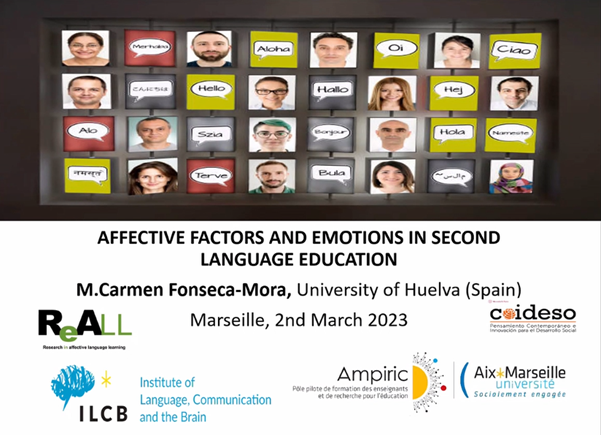Gloria Piñero Gómez, Universidad de Huelva
The ubiquitous role of emotions is evident, since all kinds of interaction are influenced by them. Thus, Second Language Education is not an exception. In fact, the engagement of the senses, emotions and imagination has been proved to accelerate and enrich learning (Gross, 1992). Considering the affective part of learners and their emotions, as well as the influence of affective factors and emotions in the teaching of second languages has been the main focus of the conference held by Dr M. Carmen Fonseca-Mora at Aix-Marseille Université on March 2, 2023.
According to Halliday (1985), language is expected to fulfil three different functions: ideational, interpersonal and textual, it is needed to understand ourselves and to communicate with others. Therefore, success in language learning depends less on materials, techniques and linguistic analyses, and more on what goes inside and between the people in the classroom (Stevick, 1980). In fact, Schumann (1999) distinguishes five key dimensions that explain human’s appraisal system: novelty, pleasantness, goal significance, coping potential and social image. Considering these aspects, a positive or negative evaluation of the second language learning situation may amplify or reduce learning. For instance, challenging action-oriented approaches are usually well-received.
Previous research trends in Second Language Acquisition and Affectivity started considering affective factors, and it was not until later that emotions were included (Dewaele, 2013). On the one hand, affective factors are stable non-linguistic factors that convey how students can respond in certain moments. They can be divided into internal affective factors – inhibition, tolerance of ambiguity, self-esteem, anxiety, beliefs, identity, motivation and attitudes – and relational affective factors – empathy, intercultural competence, acceptance of otherness, collaboration and sense of belonging (Arnold, 1999). On the other hand, emotions are more visceral and intense responses that provoke a direction afterwards. They include guilt, happiness, shame, excitement, boredom, joy, curiosity, pride, love, desire and anxiety.
The study of emotions can be classified into different areas, for example: emotional prosody and vocally expressed emotions; multilingualism, emotional expressions and pragmatics; emotions and technology; positive psychology in Second Language Acquisition; and emotional development and socio-emotional learning. However, results can vary depending on language learners’ language and culture (Dewaele, 2016; Wilson, 2013; Lemke, 2009). Other difficulties regard the human capacity to hide emotions, as well as the inherent variability in emotional responses between people in similar contexts (Dewaele, 2016).
Notwithstanding, in terms of Mahmoodzadeh & Khajavy (2019), there is an affective-cognitive variable specific to language learning which stands out because of its relevance on fostering attention, effort, and interest: Language Learning Curiosity (LLC). The combination of LLC, enjoyment and anxiety prompts willingness to communicate (WTC) to a greater or lesser extent – being curiosity the strongest predictor of WTC followed by enjoyment. Thus, arousing curiosity and enjoyment becomes essential in Second Language Education.
Imagen de StockSnap en Pixabay
In conclusion, taking emotions into account can foster WTC and understanding and acceptance of the otherness, developing consequently empathy and tolerance towards different languages and cultures. Such abilities have become much needed in our multilingual society; for that reason, it is crucial to ensure learners’ socio-emotional development.
The conference given by Carmen Fonseca-Mora is available here.



